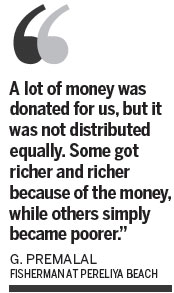Compassion heals wounds after disaster
As towering waves hit the southern coast of Sri Lanka on Dec 26, 2004, Kushil Gunasekera gathered up his children and ran for their lives to a nearby temple, the highest point they could find.
Returning later to his village in Seenigama district, he found a heartbreaking scene of death and devastation: one in four had been killed by the Boxing Day tsunami that swept across the Indian Ocean.
A decade on, Seenigama has risen from the destructions and is now a model of prosperity, thanks in large part to the efforts of Gunasekera who gave up his lucrative sugar business to devote himself to a charity he founded in 1999.
Seenigama is an outlier, however, along the ravaged coastline. Tourists have returned to the palm-fringed beaches, but livelihoods still hang by a thread in many villages that received scant assistance from the state.
In nearby Pereliya village - where more than 1,500 people perished - many feel abandoned and angry.
"Nothing has changed in our lives," said G. Premalal, a fisherman at Pereliya Beach. "We have low quality houses. A lot of money was donated for us, but it was not distributed equally. Some got richer and richer because of the money, while others simply became poorer."
More than 250,000 people died in the tsunami, which was triggered by a 9.0-magnitude earthquake off Sumatra, Indonesia.
Indonesia bore the brunt, but Sri Lanka was the next with a death toll of about 40,000.
Seenigama, about 110 kilometers south of the island nation's capital, Colombo, was hit particularly hard because reefs that might have shielded it had been destroyed by years of coral mining.
Years before the disaster, Gunasekera started his Foundation of Goodness nongovernmental organization to create alternative livelihoods for the coral miners, but the tsunami presented him with a much bigger challenge.
Seven photographs are propped up on a table in the front hall of D. Karunawathi's house, a reminder of the family members she lost in the tsunami, including her mother, sister, daughter-in-law and granddaughter. None of their bodies were found.
"Yes, we lost lives," says 60-year-old Karunawathi from her robust two-story house. "But we got a permanent home."
Beyond bricks
But Gunasekera's project went far beyond bricks and mortar. Leaning on his own charisma and connections, including some of Sri Lanka's best known cricketers, he brought together villagers, volunteers and donors, plowing financial assistance into long-term projects to build a comprehensive and sustainable model of community development.
The project now provides free services for more than 25,000 people, ranging from healthcare to vocational training and a sports academy for the young that has already produced two national-level cricketers.
The Foundation of Goodness village project depends heavily on foreign donors. The academy's cricket ground was financed by England's Surrey Cricket Club, and a swimming pool was funded by Canadian rock singer Bryan Adams.
"We harness waves of compassion to overcome waves of destruction and rebuild better," Gunasekera said. "When a tragedy like that happens, you can't reverse it. You need to look ahead and stay positive."

(China Daily 12/26/2014 page11)








